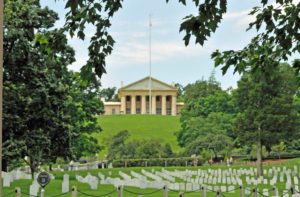
Arlington House from Arlington National Cemetery (Photo by Don Knebel)
In 1802, George Washington Parke Custis, the adopted son of George Washington, began building a massive house atop Washington Hill, just across the Potomac River from Washington, D.C. Custis wanted the house, visible from the just-completed Capitol, to be a memorial to President Washington and a repository for his memorabilia. The completed house was 140 feet wide and featured enormous Doric columns. Custis named it Arlington House after the family homestead. Upon Custis’ death, Arlington House and the surrounding 1100 acres passed to his daughter Mary, who had lived in the house with Robert E. Lee since her marriage to him in 1831. When Virginia seceded from the Union in April 1861, Lee left Arlington House to command Confederate forces and Mary left for her own safety. Union forces soon occupied Arlington House to prevent Confederate forces from lobbing cannon balls onto the Capitol from Washington Hill. In 1864, the United States government obtained Arlington House and its grounds in a tax sale the Supreme Court later held was illegal. To prevent Lee and his family from ever again using Arlington House as a residence, the Army designated the area Arlington National Cemetery and began burying Union dead close to the house.
Today, Arlington National Cemetery contains more than 400,000 graves, including that of President Kennedy. Jacqueline Kennedy selected the burial site just east of Arlington House for its spectacular view of Washington, D.C. Arlington House (once called the Custis-Lee Mansion) is now maintained by the National Park Service as a memorial to Robert E. Lee.
Comments are closed.